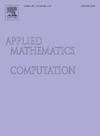A macroscopic pedestrian model with variable maximal density
IF 3.4
2区 数学
Q1 MATHEMATICS, APPLIED
引用次数: 0
Abstract
In this paper we propose a novel macroscopic (fluid dynamics) model for describing pedestrian flow in low and high density regimes. The model is characterized by the fact that the maximal density reachable by the crowd – usually a fixed model parameter – is instead a state variable. To do that, the model couples a conservation law, devised as usual for tracking the evolution of the crowd density, with a Burgers-like PDE with a nonlocal term describing the evolution of the maximal density. The variable maximal density is used here to describe the effects of the psychological/physical pushing forces which are observed in crowds during competitive or emergency situations.
Specific attention is also dedicated to the fundamental diagram, i.e., the function which expresses the relationship between crowd density and flux. Although the model needs a well defined fundamental diagram as known input parameter, it is not evident a priori which relationship between density and flux will be actually observed, due to the time-varying maximal density. An a posteriori analysis shows that the observed fundamental diagram has an elongated “tail” in the congested region, thus resulting similar to the concave/concave fundamental diagram with a “double hump” observed in real crowds.
The main features of the model are investigated through 1D and 2D numerical simulations. The numerical code for the 1D simulation is freely available on this Gitlab repository.
可变最大密度的宏观行人模型
在本文中,我们提出了一种新的宏观(流体动力学)模型来描述低密度和高密度地区的行人流。该模型的特点是,人群可达到的最大密度——通常是一个固定的模型参数——是一个状态变量。为了做到这一点,该模型结合了一个守恒定律,这个守恒定律是用来跟踪人群密度的演变的,它与一个类似汉堡的PDE相结合,这个PDE带有一个描述最大密度演变的非局部项。可变最大密度在这里用来描述在竞争或紧急情况下在人群中观察到的心理/身体推力的影响。
本文章由计算机程序翻译,如有差异,请以英文原文为准。
求助全文
约1分钟内获得全文
求助全文
来源期刊
CiteScore
7.90
自引率
10.00%
发文量
755
审稿时长
36 days
期刊介绍:
Applied Mathematics and Computation addresses work at the interface between applied mathematics, numerical computation, and applications of systems – oriented ideas to the physical, biological, social, and behavioral sciences, and emphasizes papers of a computational nature focusing on new algorithms, their analysis and numerical results.
In addition to presenting research papers, Applied Mathematics and Computation publishes review articles and single–topics issues.

 求助内容:
求助内容: 应助结果提醒方式:
应助结果提醒方式:


